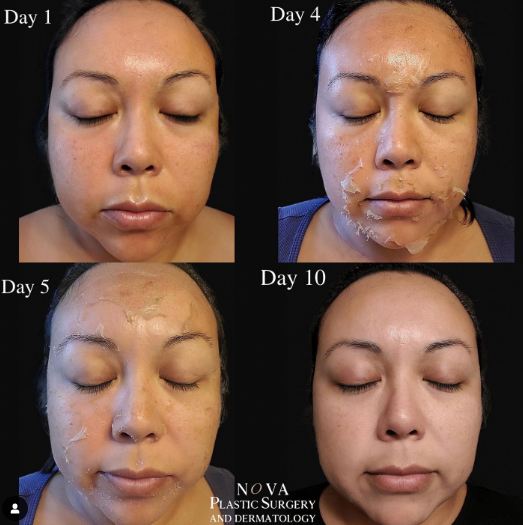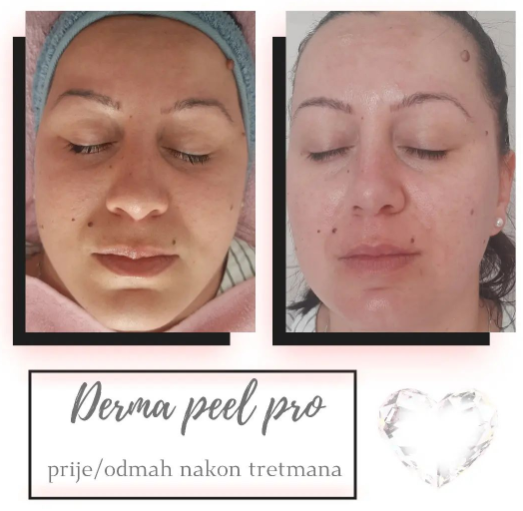In this comprehensive guide, we will explore the causes, symptoms, treatment options, and prevention strategies for derma peel gone wrong.
Derma peels, also known as chemical peels, are popular cosmetic treatments designed to rejuvenate the skin. While they can deliver remarkable results when performed correctly, there are instances where derma peels go awry, leading to undesirable outcomes.
Causes of Derma Peel Gone Wrong
Derma peel procedures can go wrong due to various factors:
1. Inexperienced Practitioners
- Derma peels should be administered by trained and experienced professionals.
- Inexperienced practitioners may use incorrect concentrations or application techniques.
2. Wrong Peel Type
- Different skin types require different types of derma peels (e.g., glycolic, salicylic, TCA).
- Choosing the wrong peel for your skin type can result in adverse reactions.
3. Preexisting Skin Conditions
- Individuals with certain skin conditions (e.g., eczema, psoriasis) may not be suitable candidates for derma peels.
- The procedure can exacerbate existing issues.
4. Lack of Pre-procedure Preparation
- Failure to prepare the skin adequately before the peel can lead to poor results.
- Proper cleansing and skin care routines are essential.
Symptoms of Derma Peels Gone Wrong
When a derma peel goes wrong, you may experience various symptoms:
- Excessive Redness and Irritation: The skin may become extremely red, inflamed, and sensitive. This is often a sign of an adverse reaction.
- Blistering and Scabbing: Severe peeling reactions can lead to blisters and scabs. These can be painful and unsightly.
- Hyperpigmentation or Hypopigmentation: Uneven skin tone may occur, leading to dark or light patches. This is a particularly frequent occurrence among individuals with darker skin tones.
- Infection and Scarring: Improper aftercare can result in infections or scarring. It’s crucial to keep the treated area clean and moisturized.

Image Source: Instagram @dermapeel
Treatment for Derma Peel Gone Wrong
If you experience a derma peel gone wrong, seek professional help immediately:
- Contact a Dermatologist: Dermatologist can assess the extent of the damage and recommend appropriate treatment.
- Topical Medications: Prescription creams may be necessary to alleviate symptoms and promote healing.
- Avoid Sun Exposure: Protect the treated area from sunlight to prevent further damage and hyperpigmentation.
- Patient Education: Learn about proper aftercare to prevent complications and facilitate recovery.
How Can You Avoid a Deep Chemical Peel Gone Wrong?
Avoiding a derma peel gone wrong involves careful preparation, selecting the right practitioner, following pre-peel and post-peel instructions, and knowing your skin type and limitations. Here’s a detailed guide on how to avoid a derma peel gone wrong:
1. Choose a Qualified Practitioner
Research and select a qualified, experienced, and licensed dermatologist or skin care professional to perform your derma peel. Look for reviews, derma peel cost range, recommendations, and credentials to ensure their expertise.
2. Skin Assessment
Schedule a consultation with your chosen practitioner for a thorough skin assessment. They should evaluate your skin type, any existing conditions, and your suitability for the specific type of derma peel.
3. Medical History Disclosure
Be open and honest about your medical history, including any allergies, previous skin treatments, medications, or preexisting skin conditions. This information helps your practitioner make informed decisions.
4. Patch Test
Ask your practitioner to perform a patch test before the full derma peel. This involves applying a small amount of the peel solution to a discreet area of your skin to check for adverse reactions or allergies.
5. Pre-Peel Skincare Routine
Follow your practitioner’s recommended pre-peel skin care routine, which may include gentle cleansing, moisturizing, and avoiding certain products like retinoids and exfoliants.
6. Sun Protection
Protect your skin from excessive sun exposure before the peel. Sunburn or tan can increase the risk of complications during and after the procedure.
7. Avoid Self-Treatment
Do not attempt at-home derma peels unless you are a trained professional. Self-administered peels can lead to unpredictable results and complications.
8. Follow Pre-Peel Instructions
Adhere to any specific instructions provided by your practitioner leading up to the procedure. This may include discontinuing certain skincare products and medications.
9. During the Procedure
Pay close attention during the peel procedure and inform your practitioner immediately if you experience discomfort, burning, or any unusual sensations.
10. Post-Peel Care
Strictly follow your practitioner’s post-peel care instructions, which typically include gentle cleansing, moisturizing, and applying a broad-spectrum sunscreen daily. Refrain from picking, scrubbing, or exfoliating the treated area during the recovery period. This can lead to complications.
11. Use Gentle Products
Use mild and non-irritating skincare products during the recovery phase. Avoid harsh chemicals or exfoliants until your skin has fully healed.
12. Stay Hydrated
Drink plenty of water to keep your skin hydrated from within, which can aid in the healing process.
13. Avoid Excessive Heat
Stay away from hot baths, saunas, and steam rooms during the recovery period, as excessive heat can worsen post-peel sensitivity.
14. Follow-up Appointments
Attend any scheduled follow-up appointments with your practitioner to ensure your skin is healing as expected.
15. Patience and Communication
Understand that the results of derma peels may take time to become evident. If you have concerns or questions, communicate with your practitioner rather than attempting DIY solutions.
By diligently following these precautions and guidelines, you can significantly reduce the risk of a derma peel gone wrong. Additionally, adhering to these measures will increase your chances of achieving the desired results while simultaneously maintaining the health and integrity of your skin.

Image Source: Instagram @dermapeel
Deep Chemical Peel Side Effects
Chemical peel side effects can vary depending on the type and strength of the peel used, but common short-term side effects may include:
- Redness: Skin may appear red immediately after the peel and for a few days afterward.
- Peeling: The treated skin may peel or flake for several days.
- Swelling: Mild swelling can occur, especially with deeper peels.
- Itching or stinging: Some discomfort, itching, or stinging may be experienced.
- Dryness: Skin may become dry and tight temporarily.
- Sensitivity to sunlight: Skin may be more sensitive to the sun, so sun protection is crucial.
- Hyperpigmentation or hypopigmentation: Changes in skin color may occur but are usually temporary.
It’s essential to follow post-peel care instructions provided by a dermatologist or skincare professional to minimize these side effects and achieve the desired results safely. Deeper peels can have more intense and longer-lasting side effects, so it’s important to discuss potential risks and benefits of derma peel with a healthcare provider before undergoing a chemical peel.
Complications of Chemical Peels
Complications of chemical peels can include:
- Infection: If proper post-peel care is not followed, there is a risk of infection.
- Scarring: Deep peels can potentially cause scarring, especially in individuals with a history of keloids or poor wound healing.
- Changes in skin color: Hyperpigmentation (darkening) or hypopigmentation (lightening) of the skin can occur, especially in individuals with darker skin tones.
- Allergic reactions: Some individuals may have allergic reactions to the chemicals used in the peel.
- Prolonged healing: Deeper peels may require a more extended recovery period.
- Unwanted outcomes: The desired results may not be achieved, or there may be uneven or unpredictable skin texture and color changes.
It’s crucial to consult with a qualified healthcare provider to assess your suitability for a chemical peel and to discuss potential risks and complications before undergoing the procedure.
Superficial Chemical Peels(Derma Peel)
Glycolic acid, a type of chemical peel agent, is often used in superficial chemical peels to address a range of skin concerns. These peels are milder in nature and target dead skin cells on the skin’s surface, making them suitable for individuals with sensitive skin or those dealing with acne.
How Does it Works
Superficial chemical peels, like those employing glycolic acid or kojic acid, are designed to improve skin texture and pigmentation irregularities. When a chemical peel is done, it gently exfoliates the outermost layer of dead skin cells, revealing smoother and brighter skin. This type of peel typically involves minimal downtime, with skin starting to peel and renew itself within 3-5 days.
However, it’s important to note that even superficial chemical peels may have side effects, including temporary redness, mild irritation, and, in rare cases, contact dermatitis. Proper skin preparation and post-peel care are crucial to minimize these risks. Additionally, while superficial peels are generally safe for people with darker skin, deeper medium or deep peels can potentially cause permanent skin damage, scarring, or uneven skin texture.
Hence, it’s essential to consult with a dermatologist to determine the most suitable type of chemical peel for individual skin needs and concerns, especially when addressing specific issues like loose skin around the eyes or skin thickening and scarring.
In summary, the careful selection of a chemical peel, whether it’s a superficial peel with glycolic acid or a medium or deep peel with trichloroacetic acid (TCA), should be based on an individual’s skin type, concerns, and desired outcomes. Proper assessment and guidance can help ensure a safe and effective chemical peel experience, leading to refreshed and rejuvenated skin.
Derma Peel Gone Wrong – Main Takeaways
Derma peels are effective treatments for skin rejuvenation when performed by skilled professionals. However, the risk of complications exists. Understanding the potential causes, symptoms, and treatment options for derma peels gone wrong is crucial for informed decision-making.
FAQ’s about Derma Peel Gone Wrong
Most frequently asked questions are as:
Q1: Can anyone get a derma peel?
Not everyone is a suitable candidate. Consult with a qualified practitioner to determine your eligibility.
Q2: How long does it take to recover from a derma peel gone wrong?
Recovery time varies depending on the severity of the reaction. The duration can vary, spanning from a few days to several weeks.
Q3: Are there any long-term effects of a derma peel gone wrong?
With proper treatment and care, most adverse reactions can be resolved without long-term effects. However, scarring or hyperpigmentation may persist in some cases.
Q4: Can you do anything at home to treat a mild reaction to a derma peel?
It’s essential to consult a dermatologist for any adverse reactions. They can recommend appropriate home care measures or prescribe medications if necessary.
Derma peels can indeed be transformative for your skin when administered correctly. However, understanding the potential risks, as well as recognizing the symptoms of complications, is essential for a safe and successful derma peel experience.
To embark on this transformative journey, it’s imperative to consult with a qualified practitioner. Moreover, prioritizing diligent aftercare measures is the key to ensuring the best results while significantly minimizing the chances of a derma peel gone wrong.